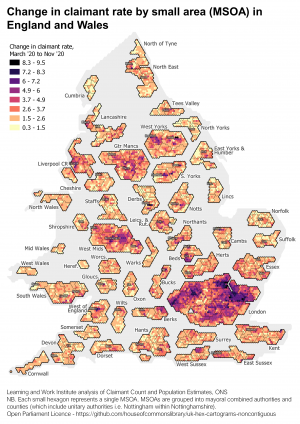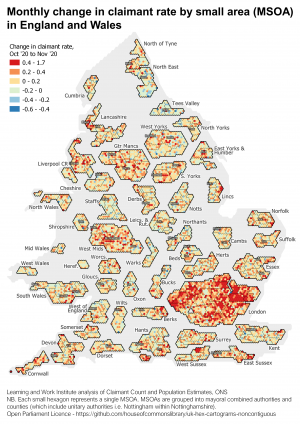Coronavirus: the local picture
By Naomi Clayton
Date:
17 12 2020Authors:
Tagged by:
Share:
Emily Maitlis debunked the idea that coronavirus was a “great leveller” in her infamous monologue on Newsnight back in April. Far from hitting rich and poor alike, coronavirus’ disproportionate impact on disadvantaged communities has become increasingly clear over the last eight months. With redundancies at their highest levels since 2010, small area data on benefit claims reveals how the pandemic is exacerbating socio-economic inequalities across the country.
Unemployment benefit claims have risen sharply in deprived areas
London has seen one of the sharpest increases in unemployment (and underemployment) related benefit claims. The proportion of Londoner’s claiming unemployment benefits rose from 3.1% in March to 7.8% in November – a larger increase than any other region or nation in the UK.
London is one of the country’s richest – and most divided – cities. A service-based economy, London’s retail and hospitality sectors have suffered as social distancing rules and travel restrictions have hollowed out the centre and businesses have been forced to close.
And it is the capital’s most deprived areas that have been most affected, with benefit claims skyrocketing. Tottenham, for example, has seen claimant rates triple over the last year.
The picture in London is mirrored elsewhere. The 25 neighbourhoods in Birmingham that have seen claimant rates increase by more than 5 percentage points since the start of the pandemic are some of the city’s most deprived.
Overall, areas with the largest increases in claimant rates tend to have large BAME populations, high rates of child poverty, low healthy life expectancies, and high levels of unemployment prior to the pandemic.

Claims continue to rise in London
The latest data shows that claimant rates continue to rise in London, particularly in its more deprived areas. The majority of areas (13 out of 18) with an increase of more than 1 percentage point in the last month were in London, with some of the highest increases clustered in east London. Coastal areas, including Great Yarmouth and Blackpool, the Isle of Wight and Crawley (where Gatwick airport is) also saw relatively high increases.
By contrast, more rural areas and parts of the North East saw a slight decrease in claimants between October and November. The claimant rate remains higher than pre-pandemic rates everywhere though.

Trends risk inequalities becoming further entrenched
These trends are not particularly surprising in many ways. If recessions have one thing in common, it is that they exacerbate existing inequalities. But the scale of the impact is different from previous recessions. And, while vaccine rollout is light at the end of the tunnel and some local economies may bounce back relatively quickly, the Brexit deadline looms and even with a trade deal, the OBR forecasts unemployment to rise to 7.5 (double the pre-pandemic figure) next year.
The challenge now is to protect the economy and limit the extent to which existing inequalities become further entrenched. Support needs to be in place to prevent long term unemployment and to level up access to good quality jobs.
Support needs to be delivered in a high quality, joined up way
‘Levelling up’ employment requires investment, careful coordination, and the ability to direct the right support to those that need it in a timely manner.
National government needs to invest in training and adult education, including extending the Lifetime Skills Guarantee, alongside back to work support. But local government have an ability to coordinate support and ensure it reflects local need (and opportunity) in a way that isn’t possible at national level.
National programmes are likely to have greater impact if delivered in partnership with local government. Local government can ensure that Restart is joined up with existing support; local leaders can promote Kickstart and drive up the number of opportunities. Research suggests that the Work Programme could have been more effective if there had been a clear role for local government.
Local government needs flexibility and funding to address local employment and skills challenges. There is an argument for bringing forward the UK Shared Prosperity Fund, which is not due to be up and running until 2022. But more fundamental change is needed, as the House of Lords Economic Affairs Committee have called for this week, with progress made on devolution. Empowering local areas is the way to address growing inequalities.
By Naomi Clayton, Deputy director for research and development at Learning and Work Institute